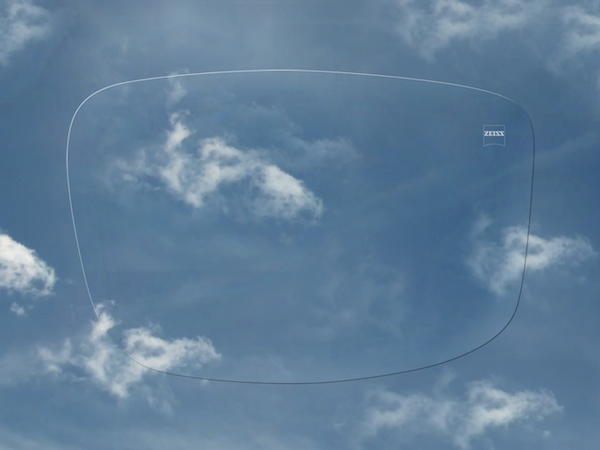Our Lenses
We proudly use and recommend ZEISS lenses
We are a premium stockist of ZEISS spectacle lenses. We highly recommend ZEISS lenses because having over 100 years of innovation in lens design, ensures you receive the very best in cutting edge lens technology.
Let ZEISS help you see your very best.
Learn more about the ZEISS lens range
Learn more about ZEISS lens coatings
ZEISS DuraVision Platinum anti-reflective layer
Lenses require an anti-reflective coating to ensure that you have clear, unimpaired vision. Light reflections – such as from reflective surfaces, lamps, wet roads or traffic at night – are reduced to a minimum and the lenses remain naturally clear. This increases wearer comfort and makes the glasses more cosmetically attractive for anyone looking at you. This way your eyes appear natural – without distracting reflections – inside or outside, day or night.



The technology behind DuraVision Platinum
The coating of every DuraVision Platinum lens consists of nine ultra-thin layers: first, the base glass receives a hard coating, followed by various anti-reflective coatings including an antistatic coating and finally by the CleanCoat layer. This topmost layer seals the lens and creates a perfectly smooth surface. Dirt and moisture bead off to enable a perfect, easy-to-clean lens.
ZEISS PhotoFusion X lenses
Light adaptive lenses that adjust to varying light conditions. Customers benefit from full UV protection and tinting to suit the changing environment they find themselves in throughout their day. With ZEISS photochromic lenses, switching between glasses is a thing of the past.



New photochromic dye molecules and new carrier matrix
The technology behind PhotoFusion X
The new speed-optimised carrier matrix gives the molecules more freedom to quickly fold or unfold at their maximum level of performance and still remain robust enough to deliver the toughness and durability expected from a premium lens material. New improved, faster dye compounds (each less than 0.3 mm in diameter), need very little light energy to react.
How to clean your lenses
When investing in high quality lenses, it is important to care for them to enjoy maximum longevity. For routine care of your spectacles, it’s important only to use microfibre lens cloths. Dust and dirt cling to them. This process, known as dry cleaning, removes particles of dirt and dust and can be carried out at any time, even when you’re on the move. If the spectacle lenses are more heavily soiled, the first step you should take is to wash them in lukewarm water. A drop of washing-up liquid makes the cleaning process even more effective. But be careful: don’t use oily or scented soaps. Oily deposits may be left behind on the lenses, causing irritating smears. Lens cleaner sprays are also very effective. After being cleaned with the spray, the lenses can then be wiped dry with a lens microfibre cloth.
Prescription spectacle lenses don’t get along well with T-shirts, jumpers, and other textiles. So even if it’s the easiest, most tempting option, it’s never a good idea to wipe your spectacles with your clothes. The danger of scratching the lenses is too high. The fact is that scratches still can’t be buffed out of lenses. So the damage caused to them will be permanent.
Every 6 months, we encourage you to stop in to our practice. We have special equipment which can be used to clean spectacles thoroughly and gently. The most important of these is the ultrasonic bath. In this process, the spectacles are placed in a special container. In the space of a few minutes, the spectacles are cleaned extremely efficiently using ultrasonic vibrations. The process cleans not only the lenses, but also the frame.

We stock pre-moistened lens wipes made by ZEISS. Individually packaged, the wipes are quickly to hand in every situation. They are pre-moistened with a special combination of two active agents, free from aggressive cleaning substances and artificial fragrances. Available also in an antifog formula.
Tips on handling your new spectacles
- As well as taking proper routine care of your spectacles, it’s also important to handle them correctly. It seems obvious, but here it is again for good measure: never place your spectacles face down on the lenses. Instead, fold them up and put them down so they rest on the frame. To avoid the annoyance of searching for your spectacles, it is advisable to always put them down in the same place. Then they’ll always be there, making it easy to find them. It’s worth pointing out at this stage that seats, chairs, and sofas are completely unsuitable places to put spectacles. It’s just too easy to sit on them by accident.
- If you aren’t going to be wearing your spectacles for a long time, such as during the night, it’s best to store them in a suitable spectacles case. This advice is especially relevant for dog owners. You might find that your four-legged friend enjoys chewing the frames, and even the lenses, of your spectacles. The result won’t just be annoying for you; it could also be dangerous for your dog.
- Something else that spectacles and spectacle lenses really don’t like is high temperatures. So whether it’s summer or winter, you should never leave your spectacles out in direct sunlight. In particular, you should avoid leaving them on the dashboard of your car. And if you visit a sauna, it is best if your spectacles don’t join you. The cold months of the year can also damage spectacles: spectacles can warp if they are exposed to very cold temperature. So it’s not a good idea to leave them in your car over night in freezing conditions.
- Your glasses need a home of their own. A hard case is the best place for your glasses whenever you are not wearing them. If you lay them down somewhere and do not have the case handy, make sure the place is safe and that the lenses are facing upward at all times. Please note that lenses made of a plastic material should not be exposed to high temperatures or significant fluctuations in temperatures. This could have an adverse impact on the durability of the coating (eg: on the anti-reflective coating). Extreme temperature fluctuations may also cause fine ripples or ruptures in the lens coating surface due to the different structures of the base lens material and coating.
